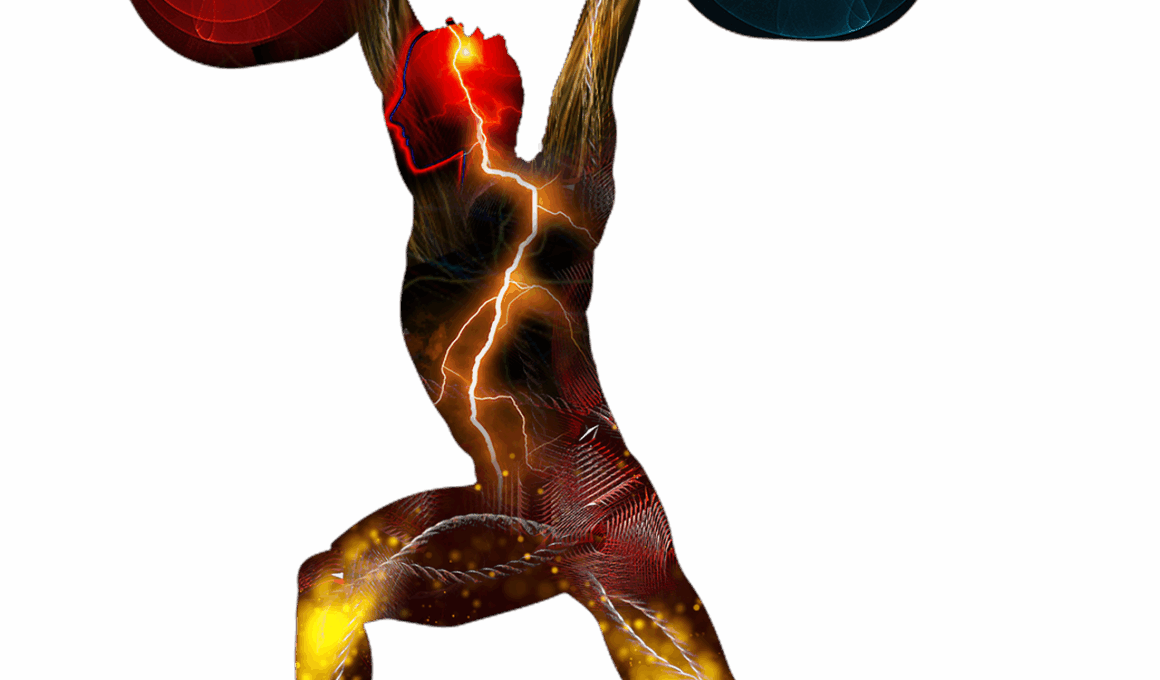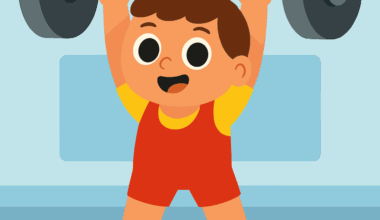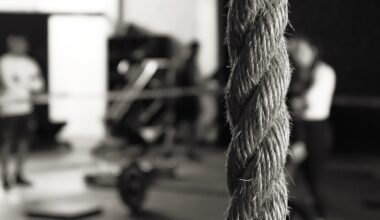Spotting Technique Flaws in Your Snatch via Video Analysis
In today’s competitive world of weightlifting, understanding your form is crucial for achieving peak performance. One effective way to assess technique flaws is through video analysis. Reviewing recorded lifts allows athletes to identify areas needing improvement. This detailed evaluation can enhance lifting efficiency. It allows coaches and athletes to visually understand lift mechanics. When examining a snatch lift, pay close attention to overall posture and technique. Focus on the position at the start, during the pull, and when catching the bar. The goal is to ensure alignment and balance at each stage. Recording lifts from multiple angles adds depth to the analysis. Front, side, and rear views provide comprehensive insight. Additionally, using slow-motion playback highlights subtle mistakes invisible in real-time. For best results, aim to film while lifting heavy weights, capturing the most challenging attempts. This provides better representation of technique under stress. Summarizing findings in a structured manner can guide future training sessions. Encourage athletes to reflect on their technique. This approach cultivates a more profound understanding of their lifts, leading to improved performance.
One primary technique flaw often observed in the snatch is improper bar path. Ideally, the bar should move in a straight line vertically. However, many lifters push the bar away from their body during the lift. This not only increases energy expenditure but can lead to missed lifts. To assess this flaw, observe the bar trajectory during the lift. Does it travel straight or does it sway? Filming from the side can provide clarity on this aspect, showing whether the bar stays close to the lifter’s center of gravity. Incorrect foot placement can also affect balance and stability. Focus on the lifter’s foot positioning when starting the lift. A common issue is lifting with feet too narrow or too wide. This can disrupt the force transfer through the legs. Analyzing from the front angle can help reveal this issue. Encourage lifters to find their optimal stance width. Additionally, monitor the landing position during the catch. The feet should be firmly planted; instability can result in dropped weights. Correcting these fundamental flaws can dramatically improve performance. Fine-tuning minor details will elevate overall lifting consistency.
Focus on Hip Extension and Body Positioning
Another significant aspect to examine through video analysis is the hip extension during the snatch. Proper hip drive plays a vital role in generating upward force. Lifters often fail to extend fully, which leads to ineffective lifts. Ensure the lifter is achieving maximal hip extension, as this is crucial for explosiveness. Filming the lift from the side highlights this, allowing coaches to discern whether the hips are driving upward adequately. Correct body angles are equally important. A forward-leaning torso can cause instability. Observers should seek a neutral spine throughout the lift. Monitoring body angles through video provides clarity. It’s essential to maintain a consistent position through the various stages of the snatch. During the second pull, focus on how the torso flows as the bar rises. A smoothly transitioning body position enhances lift execution. Look for any premature or excessive forward lean. If detected, this flaw can be remedied through specific drills. Practicing movements that emphasize upright lifting will help reinforce proper positioning. This focus encourages muscle memory. Eventually, refined hip extension leads to increased lifting efficiency and safety.
Another common mistake occurs during the catch phase of the snatch. Lifters frequently exhibit poor arm positioning and bar overextension when receiving the bar. The goal during the catch is to stabilize the weight overhead as swiftly as possible. Inspecting arrow-like semblance of elbow position during the catch is essential for monitoring strength stabilization. Video analysis from the front provides insight into how well the arms lock into place. It’s crucial for athletes to practice catching the bar with fully extended arms. Analyzing whether elbows are pointing outward versus directly underneath the bar aids comprehension. Lifters must understand that improper positioning can lead to greater risk of injury. A stable grip requires the wrists bent back to receive bar with confidence. Additionally, assess the lifter’s stance in the catch position. Feet should be positioned slightly wider than shoulder-width for stability. This presents a solid base to absorb the weight’s impact. If mistakes are evident, lifters should practice catching exercises with lighter weights. Gradual increase will reinforce proper mechanics. Monitoring this phase leads to essential insights, contributing to overall improvement in performance.
Monitoring Breathing Techniques
Breathing is a fundamental yet often overlooked aspect of performing the snatch efficiently. Correct breathing techniques can lead to increased stability and power during the lift. Observing breathing patterns can reveal various issues, such as premature exhalation or incorrect timing of inhalation. Lifters typically exhale before the catch, which can lead to a loss of core tightness. Film the lift from an angle that captures the athlete’s torso and head; this visual will let you analyze their breathing patterns effectively. Look for signs of breath-holding during the pull, as proper breathing should occur, especially during peak exertion. Stressing the importance of breath control throughout the lift can enhance focus and reduce anxiety. Suggest athletes practice inhales during setup and exhalation during the catch to balance effort and power. Breathing in sync with each pull is equally beneficial for maintaining rhythm. Specific drills can promote effective breathing techniques during training. Practicing these components can lead to improved coordination and awareness. Coaches must encourage lifters to pay constant attention to these details. Enhanced control during lifts directly affects performance. Fostering awareness empowers lifters to optimize their technique.
It’s essential to integrate video analysis into regular training routines to maintain consistent improvement. Athletes benefit most when they make video reviews a standard practice. Regular sessions allow for ongoing feedback, which fosters continuous awareness of technique flaws. Start by having lifters record their sessions at least once a week. Distributing the clips for coach-led analysis ensures that constructive feedback takes shape. Working collaboratively leads to focused discussions on what needs adjustment. Establishing consistent evaluations creates an environment of accountability for both coaches and athletes. Additionally, encourage lifters to take personal ownership over their progress. This accountability motivates them to apply coaching feedback effectively. Prioritizing the review process will enhance learning and allow lifters to track steady improvements. Integrating technology, such as analysis software, can also enhance the review process. Such tools aid in pinpointing specific errors with ease. By comparing past videos with current performance, athletes gain an overall sense of progress. Making these tools accessible promotes growth and encourages adaptability. The goal should always remain an efficient snatch lift. Therefore, consistent practice combined with constructive analysis provides massive stepping stones toward achieving excellence.
Conclusion: The Path to Improvement
Video analysis serves as an invaluable resource in recognizing technique flaws during the snatch. As athletes invest time in capturing their lifts, significant improvements emerge from this effort. Essential aspects include monitoring bar path, hip extension, arm positioning, and breathing techniques. Every detail contributes to enhancing performance strength. By assessing recorded footage, lifters can work alongside coaches to cultivate refined techniques. Practicing in an informed environment allows athletes to adopt necessary adjustments confidently. The interplay of observation and feedback enhances learning outcomes greatly. Emphasizing technique and consistency assures progress over time. It’s crucial for athletes to embrace video analysis as a means of growth, not just evaluation. With deliberate attention, lifters can transform error identification into exciting risks for improvement. Ultimately, the relentless pursuit of excellence can unlock mastery in the snatch. Coaches play a crucial role in guiding this journey, providing insights that empower athletes. Encouraging a culture of open communication and analysis fosters trust. The overall goal should be refined lifting that reflects years of hard work and dedication. Elevate your snatch lift by embracing technology and dedicated coaching for success in weightlifting.
In conclusion, successfully identifying and correcting technique flaws in the snatch through video analysis will lead athletes toward achieving optimal performance levels. Athletes today are gaining a competitive advantage using this approach effectively. Recording lifts enables step-by-step feedback essential for long-term progress. In nurturing an environment of growth, athletes unlock their potential for elevating their weightlifting skills. This dedication makes all the difference in achieving desired goals on competition day. Integrating video feedback into training promotes a professional mindset. Lifters become more aware of their body mechanics and changes needed over time. The ultimate objective remains clear: consistent improvement leading to effective lifts. To make this a reality, set structured evaluation sessions alongside regular training. Keeping athletes accountable and engaged empowers both coaches and lifters alike. Adopting a meticulously organized process encourages openness to feedback. A strategic approach to video analysis ensures every detail is scrutinized, leading to lasting success. Coaches and athletes must collaborate effectively to realize the benefits. Therefore, make video analysis a fundamental part of your training. The rewards reaped will enhance performance and contribute to overall weightlifting excellence.


